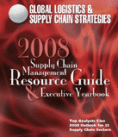
Visit Our Sponsors |
|
|
|
|
|
|
|
|
|
|
|
|
|
|
|
|
|
|
|
|
|
|
|
|
|
|
|
|
|
|
|
|
|
|
|
|
|
|
|
|
|
|
|
|
|
|
|
|
|
|
|
|
|
|
|
|
|
|
|

Analyst Insight
In the past, warehouses invested in highly automated and highly engineered material handling systems that were designed to provide the fastest possible picking for a particular business's needs. However, a host of market pressures are causing the activities inside the warehouse to change rapidly. SKU proliferation, variety of pack sizes, product lifecycle volatility, and a shift to direct-to-consumer business have rendered many highly engineered systems ineffective or obsolete. Today's distribution centers are designed around a concept of flexibility rather than around finding the perfect solution to a precise business problem that may change tomorrow.
-Ian Hobkirk, senior analyst, Supply Chain Execution, AberdeenGroup
Warehouse automation encompasses a number of different technologies, including conveyors, industrial carousels, pick-to-light systems, speech-based warehousing, AS/RS, sortation, and packaging technology.
One trend that seems to have universally impacted each of these technologies is the reduced cost of hardware as the number of providers has increased. Further, manufacturers have broken out of the old mold of selling through exclusive distributors and are increasingly taking business directly, or completely opening their lines of distribution.
Here are some recent advances in warehouse automation:
• Pick-to-light manufacturers are becoming much more creative in their product design with the goal of providing a more flexible product that can rapidly adapt as bins are re-configured. Bus technology was just the beginning-full-shelf-length digital displays are now in use.
• Conveyor manufacturers are also moving towards flexibility. Photo-eye accumulation, which was for many years a more expensive upgrade from mechanical accumulation, has now achieved price parity and allows for a greater variety of sizes/weights of products to be conveyed. Motorized roller conveyor continues to be favored due to flexibility in reconfiguring and reduced total cost of ownership.
• Sortation systems have never been available in such a wide variety of styles and configurations. Where companies once had to choose between low-cost systems with correspondingly low throughput or very high cost, ultra-high-speed sorters, a "middle class" of sorters has emerged with the use of narrow-belt technology. Today, there is truly a sorter for nearly every application. Now companies have the weapon of choice at their disposal to keep overall system cost contained without sacrificing performance.
• Industrial Carousels (both horizontal and vertical) remain, in many companies' minds, a symbol of the inflexible and expensive systems of the past, despite offering extremely high pick rates. In response, manufacturers have responded, with features such as vertical carousels that never get out of balance, multi-bay extractors for vertical lift modules, and design concepts like horizontal carousels with flexible pod configurations.
The Outlook
Packaging and Shipping-Automation to the Rescue. Much of the automation focus in years past was either to facilitate storage and picking, or to enable high-speed shipping sortation. Many operations are still under-automated in the vital section between picking and the dock doors-the packing and pre-shipping areas. As many companies are finding, this area is ripe for automation. Pre-cubing orders and picking directly to the shipping container are increasingly used as highly efficient tools to replace manual re-packing. Further, many companies have still not fully realized the business case for in-motion manifesting systems-expect this to change in the near future as well.
RELATED CONTENT
RELATED VIDEOS
Timely, incisive articles delivered directly to your inbox.







